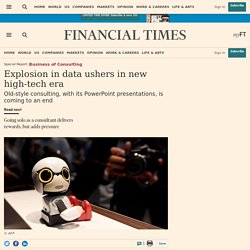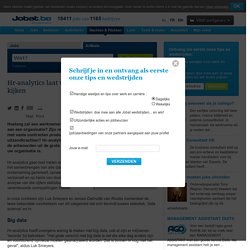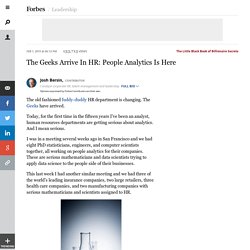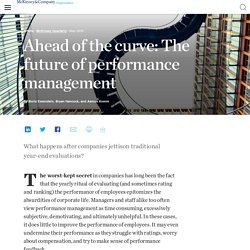

A Guide to Solving Social Problems with Machine Learning. It’s Sunday night.

You’re the deputy mayor of a big city. You sit down to watch a movie and ask Netflix for help. (“Will I like Birdemic? Ishtar? Zoolander 2?”) You’d love to move your city’s use of predictive analytics into the 21st century, or at least into the 20th century. This mix of enthusiasm and trepidation over the potential social impact of machine learning is not unique to local government or even to government: non-profits and social entrepreneurs share it as well. In applying these tools the last few years, we have focused on exactly this question. We have distilled what we have learned into a “buyer’s guide.” How machine learning can improve public policy First things first: There is always a new “new thing.” Yes. We find that there is considerable room to improve on judges’ predictions. By now, policymakers are used to hearing claims like this in sales pitches, and they should appropriately raise some skepticism.
Explosion in data ushers in new high-tech era. Delegates at an event hosted by Accenture last month in the Conrad Hotel in lower Manhattan were welcomed and registered by a smiling Amelia.

But Amelia does not work only in events. She is a hologram — a cognitive agent who can take on a wide variety of service desk roles, emulating human intelligence and capable of natural interaction with people. Sample the FT’s top stories for a week You select the topic, we deliver the news. The age of automation and artificial intelligence (AI) has been predicted for decades — and it may finally be arriving, thanks to the explosion in data, the fuel that powers the AI machines. Consulting firms are not only implementing automation and AI for clients but also using it to transform their own back-office functions and operations. Crafting a talent analytics function and building strategic partnersh…
HR meets science at Google with Prasad Setty. Hr-analytics laat werkgevers in de toekomst kijken. "Wie trends, evoluties of vermoedens kan staven met cijfers, heeft de aandacht van de directie.”

(Luk Smeyers, iNostix) Hoelang zal een werknemer trouw zijn aan een organisatie? Zijn medewerkers met vaste contracten productiever dan uitzendkrachten? Hr-analytics distilleert de antwoorden uit de grote cijferbrij die uw organisatie is. Hr-analytics gaat over meten en weten. The Geeks Arrive In HR: People Analytics Is Here. The old fashioned fuddy-duddy HR department is changing.

The Geeks have arrived. Today, for the first time in the fifteen years I've been an analyst, human resources departments are getting serious about analytics. And I mean serious. I was in a meeting several weeks ago in San Francisco and we had eight PhD statisticians, engineers, and computer scientists together, all working on people analytics for their companies. These are serious mathematicians and data scientists trying to apply data science to the people side of their businesses. This last week I had another similar meeting and we had three of the world's leading insurance companies, two large retailers, three health care companies, and two manufacturing companies with serious mathematicians and scientists assigned to HR.
Anostix: Predict Your Employees’ Business Impact with HR Analytics Ahead of the curve: The future of performance management. What happens after companies jettison traditional year-end evaluations?

The worst-kept secret in companies has long been the fact that the yearly ritual of evaluating (and sometimes rating and ranking) the performance of employees epitomizes the absurdities of corporate life. Managers and staff alike too often view performance management as time consuming, excessively subjective, demotivating, and ultimately unhelpful. In these cases, it does little to improve the performance of employees. It may even undermine their performance as they struggle with ratings, worry about compensation, and try to make sense of performance feedback. These aren’t new issues, but they have become increasingly blatant as jobs in many businesses have evolved over the past 15 years. Yet nearly nine out of ten companies around the world continue not only to generate performance scores for employees but also to use them as the basis for compensation decisions.
Answers are emerging. But change they must. Big Data in Human Resources: Talent Analytics (People Analytics) Comes of Age. Gartner expects the market for BigData and analytics to generate $3.7 Trillion in products and services and generate 4.4 million new jobs by 2015.

While most of the talk is about applying BigData to marketing and consumer businesses, there is an even bigger opportunity to apply BigData to Human Resources. (We call it Talent Analytics - now renamed to People Analytics) What is BigData in HR? There are around 160 million workers in the US alone, and most companys' largest expense is payroll. In fact in most businesses payroll is 40% or more of total revenue, meaning that total US payroll expense is many billions of dollars. How well do organizations truly understand what drives performance among their workforce? The answer to most of these questions is no. This is like the Vice-President of marketing spending millions of dollars on a new marketing campaign because he or she "always does it this way. " An Example: Hiring the Best Sales Person. Forbes Welcome.